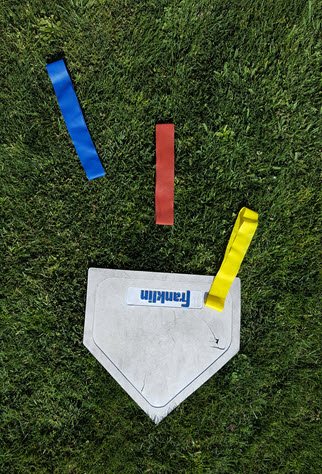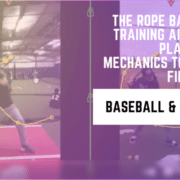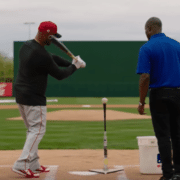Hit Baseball Or Softball In Certain Direction Like Place Hitting To Opposite Field At Home By Yourself Indoor Drills With Limited Space
Discover how to hit a baseball or softball in a certain direction, like place hitting to the opposite field, at home by yourself using indoor drills with limited space.
How To Optimize Directional Force Using The “Pounding Nail” Drill
Most likely, Little Leaguers and 12-year-old young ladies won’t be driving the ball 400-feet anytime soon. I know that. However, the point of this “Pounding the Nail” drill video post is how to train hitters to direct their swing force optimally. In the above video, we go over…
- Thanks to Matt Nokes,
- Define Directional Force, takes 8,000 pounds per square inch, in one direction, to hit ball 400-feet,
- What is a Lumberjack trying to do? Lean in and compress the baseball,
- Using colored bands on ground to simulate pitch location directional force (see image of plate and colored bands below), and
- Stand out front of hitter with external image (nail).
I like to pair the above “Pounding the Nail” drill with the following “Shorten Swing” drill…
However, I’ve evolved my thinking on the latter video. And here it is:
- The “catcher’s glove” ball marker closest to the actual catcher is outer 1/3 of plate right-center approach (for righty, reverse for lefty),
- The “catcher’s glove” ball marker inline with the back foot is middle 1/3 of plate dead-center field approach, and
- The “catcher’s glove” ball marker inline with hitter’s belly button is inner 1/3 of plate left-center field approach (for righty, reverse for lefty).
SCIENCE-BASED TRAINING:
Improve your hitting strategy dramatically by applying human movement principles.
Learn not only how and what to train but also the science behind the methods.
I see coaches generally teaching a “kicking back” of barrel towards the catcher. I found deeply accelerating barrel same for all pitch depths to be ineffective for my hitters. As you’ll see in the syncing of these two drills, the distance between what catcher’s glove the hitter hits and the depth of impact is the same.
For example, the DISTANCE between hitting catcher’s glove position #1 above to optimum impact on the outer 1/3 of the plate SHOULD MATCH hitting catcher’s glove position #3 above to optimum impact on the inner 1/3 of the plate. You still following me?
I was teaching the same blanket “deep barrel” acceleration as everyone else, but my cleaner hitters mechanically were having a challenge barreling up the inner 1/3 pitch. You see, their swing path was taking too long in getting to the inner 1/3 pitch with the generalized “deep barrel” approach.
I recommend watching video of top hitters smashing the inside versus the away pitch and in most cases, you’ll see a difference in what catcher’s glove they’re hitting. Remember the objective is directional force. Matt Nokes says that is takes 8,000 pounds per square inch of force, in ONE DIRECTION, to hit a ball 400-feet. Practice syncing these two drills with your hitters in the following progression:
- Dry swings first,

“Pounding Nail” Drill colored band staggered impact setup to simulate pitch depth (for a righty, reverse for a lefty)
- Tee next,
- Then soft toss (DO NOT work the “deep” catcher’s glove position here, unless you’re okay with donating your teeth!)
- And when you get the hitter to LIVE, make sure they understand before pitcher throws the ball, they default to the middle approach, and make the smaller adjustment in or out, depending on pitch depth.
PLEASE NOTE: once the hitter gets to LIVE, make sure they understand the following:
- Most optimized force = pounding nail over correct part of plate (ex. for righty, driving inner 1/3 to left-center),
- Optimized force = slipping lines, and pounding one nail over (ex. for righty, driving middle 1/3 to left-center), and
- Sub-optimal force = slipping lines, and pounding two nails over (ex. for righty, driving outer 1/3 to left-center).
Just think about it, if it takes 8,000-pounds per square inch of force in one direction to hit a ball 400-feet, and that’s optimal…what happens if the hitter uses “Sub-optimal force” like in the above bullet point? Right! It’s going to take more force to hit it farther. I dunno how much, but taking a guess in the aforementioned sub-optimal example, it may take 12,000 or 16,000-pounds per square inch of force to hit the ball 400-feet pounding two nails over, so make it easy..hit it where it’s pitched!
After this lesson, typically the “light-bulb” goes on with my hitters. I hope this helps!
- Fix Your Child’s Fear of the Ball Fast: Proven Hitting Drills to Stop Flinching at Pitches—Trusted by Top Youth Baseball Coaches - July 12, 2025
- Fix Your Little Leaguer’s Hitting Slump Fast – Proven Confidence Drills & Mental Reset Tools (Used by Top Youth Baseball Coaches) - July 9, 2025
- Best Hitting Drills for 8-Year-Olds (2025): Fix Swing Flaws Fast with This MLB-Trusted Youth Baseball System—At-Home, Step-by-Step, and Built for Game-Day Confidence - July 5, 2025














Hey Joey, Great external cues!
Thanks Bill!
Great video Joey.
I agree totally. I use Matt Nokes around the Horn angle drill with my guys to emphasize directional force. When I set up at different angles, and toss the ball in the direction of their nose, they should hit the ball at a 45 degree angle from the line it comes in on. These angles allow for optimum carry in batted ball distance. If you add hand and barrel speeds to contact force which is comprised of 4 areas. Hand path, weight transfer, impact position of the hands and barrel and the type of bat being used (length and weight) plus velocity of incoming pitch, overall batted ball distance is obtained based upon launch angles positive or negative. So directional force is a huge factor in generating power. Well done my friend. Take care Joey.
Coach DeLong
Coach DeLong, don’t worry I know what you were referring to. Great drill by Nokes. Thank you and keep up the great work my friend.
Correction, it was Matt Nokes Around the Zone drill